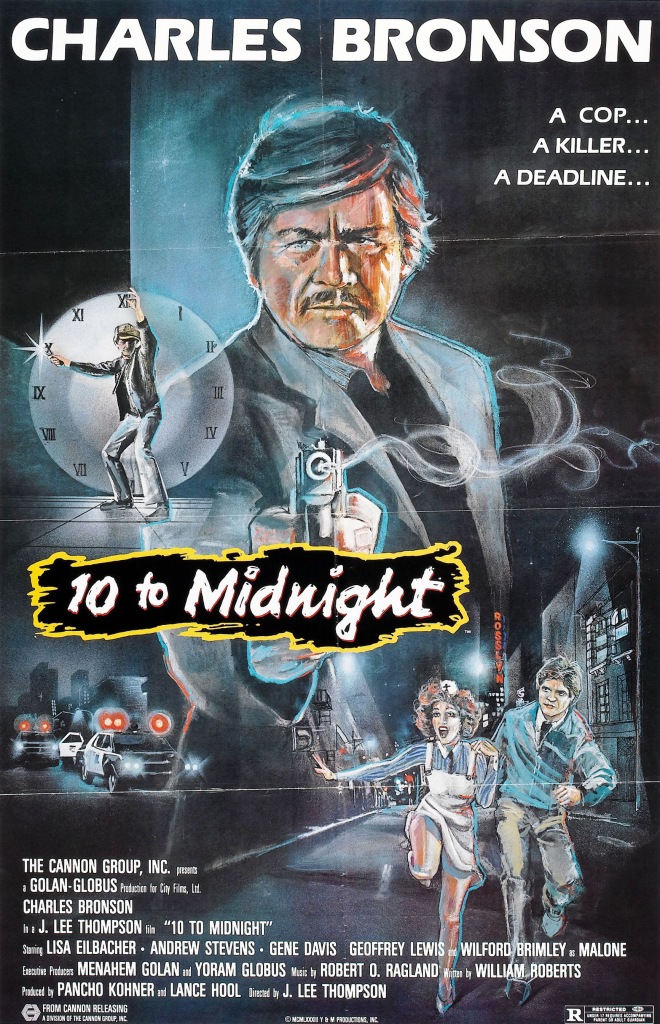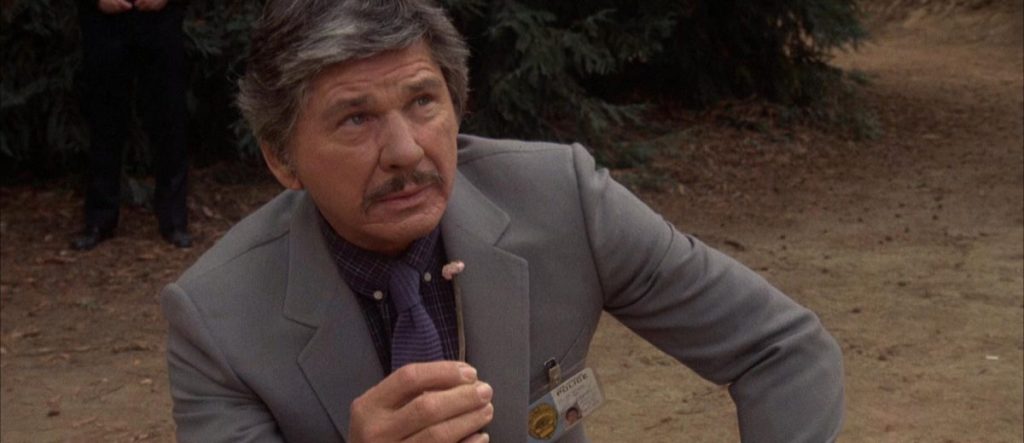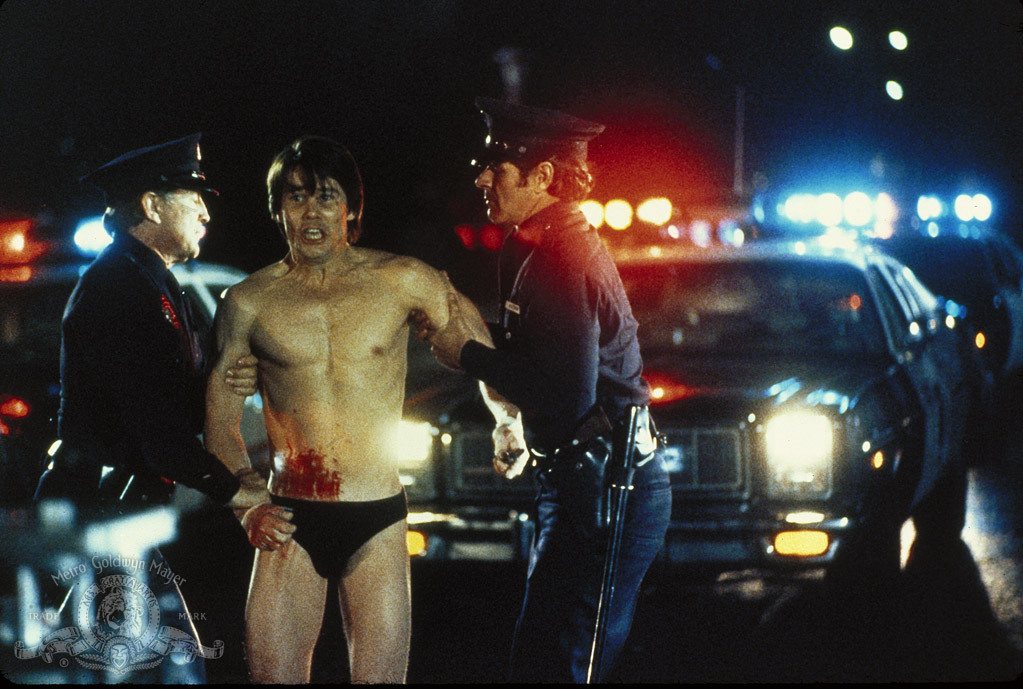
10 to Midnight was directed by J. Lee Thompson, written by William Roberts, and stars Charles Bronson, Andrew Stevens, Gene Davis, Lisa Eilbacher, and Wilford Brimley. It follows a cop and his partner as they trail an active serial killer targeting young women.
The Plot: Cannon films aren’t known for their complex narratives, or even for their narratives in general. Their target audience wanted the nitty gritty, and Roberts obliged with his thin story filled in with just enough scrounged up tropes to tie things together.
For some, dates don’t come easily. For Warren (Davis), they don’t come at all. 10 to Midnight all but starts with his predicament in text form and progresses to the murder of a naked woman in the woods. In equally short order, which is how just about everything plays here, police captain Malone (Brimley) finds the body and calls on Detective Kessler (Bronson) and his (very) newly assigned partner McAnn (Stevens) to fill in the blanks. Logistically, things get shaky under Thompson, but the plot isn’t meant to thicken, only to proceed.
At the funeral for the murdered girl – who happened to be friends with Kessler’s daughter, Laurie (Eilbacher) – a spectating Warren catches sight of his new target. It won’t come as much of a surprise when Kessler tries to put Warren away after getting an idea about the maniac, but can’t, making an enemy out of the killer. The screenwriter for 10 to Midnight lets the inevitable chase become the plot, which isn’t much of an improvement or downturn from what came before; it’s perfectly functional.
The Characters: In an expected development, the characters of a Bronson starrer aren’t filled to the brim with depth or emotive capacity. Everyone fills their roles adequately but without deviation from the standards of the general plot.
Kessler is a man who tries to keep his emotions buried under the details of his job. He doesn’t talk much except to grasp said details and prefers to get in and get out before long but is willing to stick around for as long as it takes to indict a perpetrator if he’s sure he’s got the right person. It’s a cut and dry archetype for Bronson, including the presence of a daughter, who’s not given any real personality or life other than her similarly stolid speech patterns and attraction to McAnn.
McAnn fills out the rookie partner checklist requirement effectively enough. His cockiness and motor mouth expectedly puts him at a disadvantage when placed with Kessler, who immediately thinks negatively about the man, but 10 to Midnight doesn’t make a real conflict out of the clashing personalities; it only mentions it. McAnn doesn’t talk or act like a cop, which gives him some differentiation, but there’s nowhere for the character to go.
Warren is the only properly understood character of the feature. For the time that Thompson directed the movie, his motives were bizarre or unheard of, but now there’s a bit of accidental relevance. Warren desperately wants attention from the fairer sex, and gets some leeway from his attractive appearance, but his inability to act normal rebuffs whatever mileage he may get. He’s stuck in place and will do just about anything to get out, including focusing on his fashion and hair, endless flirtation, and obviously murder. There’s not much else to him aside from his predicament, but the less is more approach works here where it didn’t for the rest of 10 to Midnight’s characters.

The Crime: Continuing with the streak of predictability, the movie doesn’t have any new or creative methods of perpetuating or stopping its criminal element. It goes through the motions perfunctorily, again, without much setting it apart.
Nudity is basically all that keeps the actual crimes of 10 to Midnight vaguely memorable. In a moderately disturbing development, Warren commits his generic stabbings completely nude. There’s no consistent M.O. in where, when, or how quickly Warren kills a young girl that gets clarified throughout the movie. However, there is a cleanliness to the way the killer covers his tracks, making sure to be seen for his alibi before striking. The unclothed kills might be memorable, but only for that addition (subtraction?).
Procedural investigative work is equally generic under Thompson, who predictably has Kessler get a few clues out of their initial interview with the suspect, only to not quite have the necessary evidence to put Warren away. It gets redundant when Kessler and McAnn run into the same problem twice in 20 minutes, and the stasis doesn’t get remedied when Kessler tries to forge evidence to convict the suspect, as that attempt falls through quickly. There’s some utilization of Laurie to record one of Warren’s phone calls and other sorts of scenes like that, but it’s all old hat police work.
Backup details like Malone wanting the two detectives off the case but letting them stay on anyway and Kessler having to reveal murders to surviving family members are here, like one would expect, but feel included out of necessity. Like the director knew that 10 to Midnight brought nothing new to the evidence board, which it doesn’t; there’s a significant lack of anything remarkable.
The Technics: Thompson, Bronson and Cannon all had a friendly relationship with one another. It’s a shame that a director as middling as Thompson had to be a part of that trifecta since his blandness only makes 10 to Midnight all the more familiar.
As was the way of the production company, helmers were rarely hired for their filmmaking style, instead they were hired for the ability to pump out product. Indeed, this second reunion with Cannon and the fourth with Bronson, yet the direction is pallid to a fault. Scenes are strung together in a perfectly milquetoast way, most beats add up to a finished feature, and there’s a little extra time for a romantic subplot, but everything is filmed with so little flair that it’s maddening.
Pacing is a bit of an issue for 10 to Midnight and films similar to it in that it’s hard to want to stick around for 100 minutes when 95 of them are instantly familiar and unenthusiastically executed; and 10 of them could’ve been cut with little effect on the final product. That’s not to say the movie is terribly paced by itself; no, it’s perfectly acceptable and forgettable, but with a quicker cut, it might’ve had more staying power. As it stands, it’s just another middling facet of an averagely done film.
It’s not a terrible film, but 10 to Midnight is something of a memory vacuum. You’ll know you’ve seen it, but almost nothing will separate it from the other crime films you’ve seen either. It most certainly exists, and that’s the best compliment it can get.
45/100
Misc details
Release date (US): March 11, 1983
Distributor: Cannon Films & MGM (originally) | Shout! Factory (as of writing)
Runtime: 101 minutes
MPAA rating: R


Leave a comment